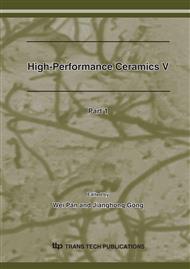p.656
p.659
p.663
p.666
p.669
p.672
p.675
p.679
p.683
A Novel Temperature Induced Gelation Forming Method
Abstract:
We describe the production of complex shaped ceramic green bodies with high strength and reliability using a novel forming method: temperature-induced gelation. Gelation is performed by moderately decreasing the temperature of the suspension, which induces in situ gelation and forms a network to bridge the suspended particles, leading to a stiff green body. The gelation mechanism is based on the separation of dispersant KD1 from solvent or the collapse of adsorbed layer on particle surface, which depends on the stability of starting suspensions.
Info:
Periodical:
Pages:
669-671
Citation:
Online since:
February 2008
Authors:
Price:
Сopyright:
© 2008 Trans Tech Publications Ltd. All Rights Reserved
Share:
Citation:


